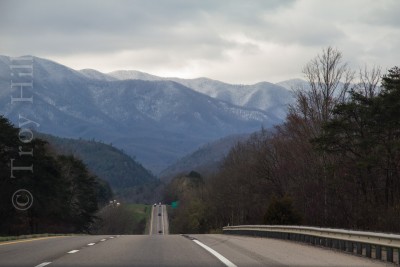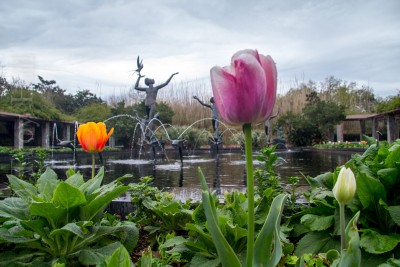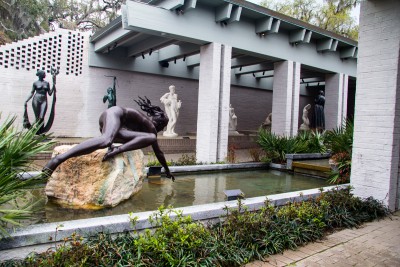Road trips can be both fun and stressful Fortunately, our recent trip out to South Carolina was the former, not the latter. But, it’s, even more, fun when you’re not sure if you’ve brought along a spirit or two.
 Color me a skeptic. I’ve not seen or experienced anything first hand, but enough has happened that I wouldn’t have been surprised if Abe Lincoln’s ghost appeared and chewed me out for being a Yankee in the south.
Color me a skeptic. I’ve not seen or experienced anything first hand, but enough has happened that I wouldn’t have been surprised if Abe Lincoln’s ghost appeared and chewed me out for being a Yankee in the south.
Fortunately, that didn’t happen. In fact, very little happened, but just enough to cause me to scratch my head in wonder.
My wife’s father died in his sleep about 20 years ago.
Ever since then, the family had half-joked about the uncanny appearance of a few coins – usually a quarter or two – they’d find when traveling. “Dad’s here,” they’d say of wife’s father, remembering his penchant for dispensing quarters to the grandkids when they were around.
With a 12+ hour drive out to Myrtle Beach from Indiana, we joked in the car and wondered who would find the coins this trip.
“I’d like real silver,” my wife said aloud.
“You hear that Pete,” added my sister-in-law’s roommate from the back seat, as I drove. Roomie had been a friend of their family longer than my wife and I had been married. As a youth, she was best friends with Sis, Wife, and their entire family. She knew their father’s name wasn’t really “Pete,” but that’s what everyone in town called him. Growing up in rural Indiana, sometimes your name wasn’t always the one given to you at birth.
“She wants some silver this time” Roomie adds.
“Something from before 1964, when it was real silver,” my wife chimed in. We laughed, we joked, and promptly forgot about the episode. We opened a bag of Twizzlers. Miles to go, hours to drive -road trips.
Once we hit our condo on the beach, the girls began planning our itinerary. Being the lone male in the group, my job was to give input, then agree with whatever the ladies decided. They decided that we would visit Brookgreen Gardens the next day. Rain was in the forecast, and the gardens seemed likely to have many pavilions scattered about to duck into in order to escape the rain as the need arose.

Brookgreen Gardens is a beautiful set of four former plantations (The Oaks, Brookgreen, Springfield, and Laurel Hill), set in the rice area of the lowcountry of South Carolina. Two rivers parallel each other through this area, and the Alston family grew their plantation into a major source of rice production until the civil war. Being close to sea level, with nearby rivers, the area gave easy access to the waters to flood the rice patties several times a year.
The area, now beautiful, has a checkered and ugly tinge to its past. Brookgreen Plantation was once owned by Joshua John Ward, the largest of American slaveholders. Before his death, when the plantation was transferred to his heirs, he held up to 1,092 humans in slavery.
In contrast to that ugly past, the gardens today contain beauty of many sorts, from plant to sculpture. The land was purchased by Archer and Anna Huntington prior to WWIl. The Huntingtons envisioned a public garden space to showcase sculptures from Anna, her sister Harriet Hyatt, as well as other American artists. The former plantations land is now home to extensive gardens and galleries of American sculpture. In addition there is a small zoo, and the historical areas of the Alston family’s Oaks plantation to the south end, as well as Springfield and Laurel Hill plantation to the north end.
Brookgreen is an easy drive from Myrtle Beach. We didn’t even need to break into the Twizzlers for the 30 minutes we drove through the grey, overcast weather. We scooted through the entryway right ahead of busload of tourists. As we paid our entry at the main gate, we learned that our admission was good for up to seven consecutive days. There is enough to do, enough to see, that we could have easily come back later in the week.
By the time we made a quick stop at the information center to get maps, the busload of tourist had caught up with us. The sky had shifted from a light, spotty drizzle to a steady rain. So we, along with many of the tourists from the bus, made our first stop on the grounds the gift shop. Eventually, the rain eased up, and we headed out to see the gardens. I was not surprised to see that most of the humans featured in the sculptures are mostly or wholly nekkid. Clothing seemeds optional to the point of extinction for the artists featured here. Prudish folks should probably skip the gardens, and head to the lowcountry zoo at the north end of the gardens.

We spent a couple of hours touring the gardens and looking at the vast array of art. We finally found ourselves at a crossroads. It was nearing lunch time, and the main cafe was back near the garden’s main entrance. We want to head out on one of the cultural tours, which depart from the Lowcountry store, nearer to the other end of the gardens. We were warned as we arrived, that the smaller cafe at the Lowcountry store had a VERY limited menu. Sis is a vegetarian, so we tried to be mindful of where we stopped to eat, in order to make sure she had plentiful options on the menu.
We weren’t sure we had time to head back to the main cafe for lunch, and still make the cultural tour at the Lowcountry store. Sis told us not to worry, since she wanted to make sure we got a tour of one of the plantation sites in. The smaller cafe at the Lowcountry store surprised us, however, with more than a few choices. Roomie and I decided to try pulled pork sandwiches with chips. Sis ordered a vegetarian sandwich wrap. My wife’s lunch of microwaved chicken nuggets was the only disappointment. She wasn’t happy when she realized the chicken was going to be microwaved. Evidently the formula for creating rubber chicken involves microwaving nuggets.
After lunch, we got our tickets for a tour of The Oaks Plantation. We boarded the small white bus, with another family of four. Once onboard, Theresa, our driver and tour guide told us all to buckle up, as we headed out into rough, bumpy areas. She pulled the short white bus off the main drive, and headed cross country. Her insightful commentary was informative and humorous as we headed up the dirt track between rows of trees planted by later generations of the Alston family toward the area where their plantation houses once stood.
We stepped cautiously out of the bus, on the heels of Theresa’s caution that South Carolina is home to all four varieties of poisonous snakes in the US. I made sure to watch my step carefully, glad that the critters would be sluggish in the overcast chilly spring day.
Theresa lead us around the clearing where the Alston family’s main house had grown. She points out the barely visible footprint of the foundation among the leaves and overgrowth that consumes old and ancient structures. While not a photographic location, with little more than trees and information panels in the area, our guide’s commentary is interesting as she weaves tales of how each generation of the Alston patriarchs, alternating between Williams and Josephs, built and grew the plantation that would continue to grow and be split amongst later generations.
Back on the bus, we bounced along the dirt track to find the Alston family cemetery. I recalled our conversation in the car on the drive to South Carolina. This might be a good place to find some pre-1964 silver coins. Or a ghost. Cemeteries seemed like a good place for a ghost to hang out. This one, however, despite being remote -with no highway noise, just nature all around – wasn’t extreme on the creep-out meter. It was well tended, but old.
Our guide slid the metal bar from its latch, and swung the simple, yet ornate gate wide. The lack of squealing metal on rust showed the upkeep and care that Brookgreen’s staff provides to the memory of the Alston family.
The once pristine bricks that were laid to form the equidistant cross shaped walkways, bisecting the square walls of the garden, were lined with green moss. The bricks lay unevenly across the ground near a centuries old oak tree. It’s roots reached out and thrust the carefully laid bricks upward. Theresa cautioned us to watch our step on the uneven surface. A coating of brown leaves from last autumn lay scattered across the bricks and The shoulder-high brick wall also bore a green mossy coating along it’s top, more like a gothic buzz cut atop the cemetery’s head.
The cemetery is the final resting place of many of the Alston family. Notable members include Governor of South Carolina during the War of 1812, Joseph Alston, and a memorial to his wife, Theodosia Burr Alston. She was the daughter of US Vice President Aaron Burr. Theodosia was lost at sea while on a trip to see her father in New York, following the death of the couple’s only child, Aaron Burr Alston, who is interred next to his father in the cemetery.
The tour concluded with a visit to the site of the slaves’ small village. More brown leaves rustled across the outlines of the wooden stakes and ropes that mark the former foundations of the various structures in the small village. Theresa pointed out that archaeological work is still ongoing at the site. While digs to uncover artifacts do occur frequently, they always re-cover the sites to prevent further erosion and destruction of any artifacts not yet recovered. She filled in many details of how slaves lived in the cramped quarters, and learned to exist in the antebellum south.
Following the tour of the Oaks Plantation, we headed out into the Lowcountry trail, and into zoo area. In addition to a gator or two, some river otters, and lots of herron varieties, the zoo includes two bald eagles which were injured by gunshots, and have lost part of their wings. We were able to get with ten feet or so of the majestic birds in their outdoor pen made of black mesh netting.
Roomie was put off by the attitudes of several of the herron in a large, netted pen that we entered and walked through. One in particular squawked loudly as we entered the enclosure through the two mesh doors. One wouldn’t open, unless the other door was shut – in order to keep the birds in. She pulled up the hood on her jacket, protecting her hair from any plummeting “presents” from overhead birds.
Our feet sore and tired, we headed back toward the parking lot. The sun had come out full force after a day of rain and clouds. Another quick drive took us back to Myrtle Beach. We managed to get in a little more walking as we headed out for dinner down by the boardwalk. While down there, we made sure to stop at Mad Myrtle’s Ice Cream parlor. Wife and Sis wanted to get a photo to send to their mother, Myrtle, back home.
Roomie, not in the mood for ice cream headed out to wander the area around the small eatery while the rest of us sat and ate our ice cream.
Coming back in from her sojourn, Roomie walked up to the table. She bent down, and reached under the chair Sis was on. She stood, and handed something to Sis, who looked at it and grinned.
She handed it to my wife, who turned the round coin over in her hand. “It’s not silver,” she announced, grinning.
“Pete,” Roomie announced to the empty air around us, “she wanted silver.”
“Of all the places this week to find a coin,” I added, “it had to be the place with the same name as your mother.”
Sis grinned. “Thanks Dad,” she said.



